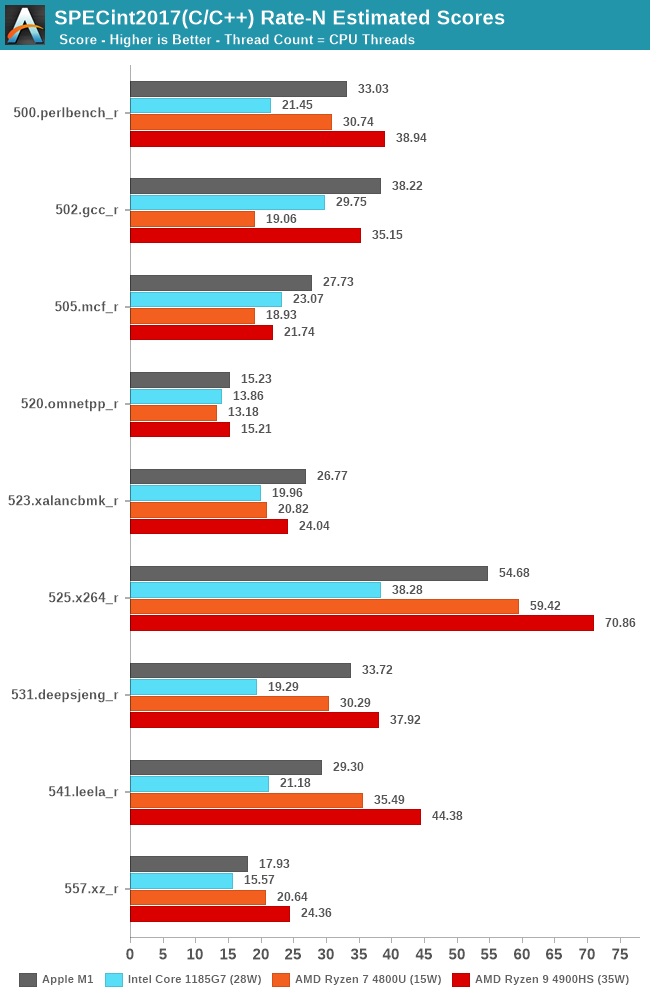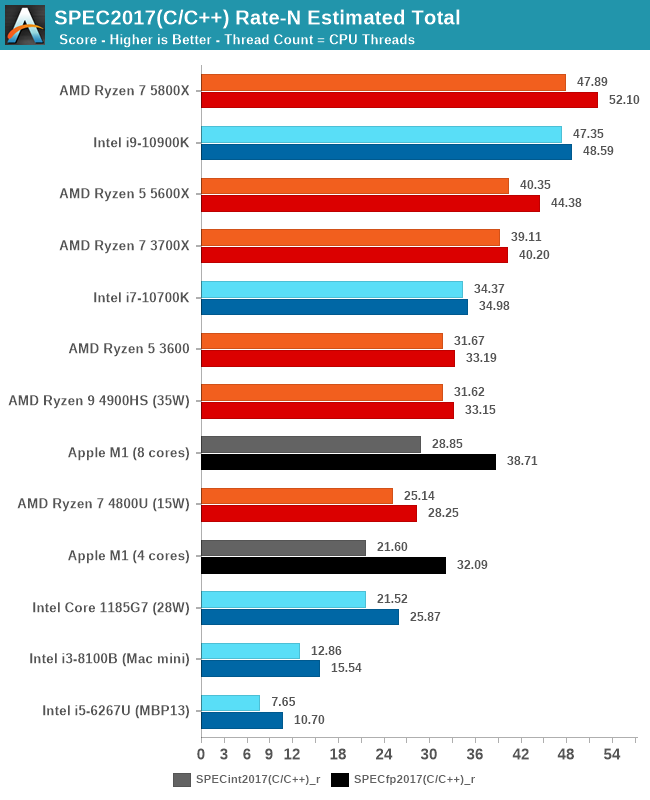The 2020 Mac Mini Unleashed: Putting Apple Silicon M1 To The Test
by Andrei Frumusanu on November 17, 2020 9:00 AM ESTSPEC2017 - Multi-Core Performance
While we knew that the Apple M1 would do extremely well in single-threaded performance, the design’s strengths are also in its power-efficiency which should directly translate to exceptionally good multi-threaded performance in power limited designs. We noted that although Apple doesn’t really publish any TDP figure, we estimate that the M1 here in the Mac mini behaves like a 20-24W TDP chip.
We’re including Intel’s newest Tiger Lake system with an i7-1185G7 at 28W, an AMD Ryzen 7 4800U at 15W, and a Ryzen 9 4900HS at 35W as comparison points. It’s to be noted that the actual power consumption of these devices should exceed that of their advertised TDPs, as it doesn’t account for DRAM or VRMs.

In SPECint2017 rate, the Apple M1 battles with AMD’s chipsets, with the results differing depending on the workload, sometimes winning, sometimes losing.

In the fp2017 rate results, we see similar results, with the Apple M1 battling it out with AMD’s higher-end laptop chip, able to beat the lower TDP part and clearly stay ahead of Intel’s design.

In the overall multi-core scores, the Apple M1 is extremely impressive. On integer workloads, it still seems that AMD’s more recent Renoir-based designs beat the M1 in performance, but only in the integer workloads and at a notably higher TDP and power consumption.
Apple’s lead against Intel’s Tiger Lake SoC at 28W here is indisputable, and shows the reason as to why Apple chose to abandon their long-term silicon partner of 15 years. The M1 not only beats the best Intel has to offer in this market-segment, but does so at less power.
I also included multi-threaded scores of the M1 when ignoring the 4 efficiency cores of the system. Here although it’s an “8-core” design, the heterogeneous nature of the CPUs means that performance is lop-sided towards the big cores. That doesn’t mean that the efficiency cores are absolutely weak: Using them still increases total throughput by 20-33%, depending on the workload, favouring compute-heavy tasks.
Overall, Apple doesn’t just deliver a viable silicon alternative to AMD and Intel, but actually something that’s well outperforms them both in absolute performance as well as power efficiency. Naturally, in higher power-level, higher-core count systems, the M1 can’t keep up to AMD and Intel designs, but that’s something Apple likely will want to address with subsequent designs in that category over the next 2 years.










682 Comments
View All Comments
realbabilu - Thursday, November 19, 2020 - link
Since Catalina,intel compiler mafia have issue and incompatibility. The big sur have worse compatibility.https://community.intel.com/t5/Intel-C-Compiler/In...
That's why my hackintosh stay at mojave. The only works for now is gcc apple, and it doesn't have gfortran. I don't know if latest gnu gcc Catalina could works in big sur rosetta 2.
realbabilu - Thursday, November 19, 2020 - link
Dull t9Should be intel compiler have issue
Phemg - Thursday, November 19, 2020 - link
It would be nice a comparison of multi-thread against efficiency cores...QuantumKot - Thursday, November 19, 2020 - link
I wonder whether Apple has removed support for 32 bit instructions from the M1 hardware altogether or it is still there just in case?Jenoin - Thursday, November 19, 2020 - link
"it takes a Ryzen laptop with a Radeon 560X to finally pull even with the Mac Mini"Oh really? A Ryzen, that was the slower of two products in it's product stack, when it launched 3(!) years ago on a 14nm process coupled with a 2 year old refreshed version of a refreshed version of a refreshed version... 14nm GCN based GPU. What do you think the market value of such a laptop would be today assuming you could find one new? $250? $300? This comparison and the language used for it is disingenuous at best.
What a joke.
hagjohn - Thursday, November 19, 2020 - link
Apple Silicon allows Apple to be in the drivers seat. There is no more waiting for intel to release products, which has been pretty hard lately. They have done a damn good job with their first product. I'm excited to say I ordered a M1 Mini (16GB/1TB) and I can't wait to get it.Alexvrb - Friday, November 20, 2020 - link
I'd like to see Rosetta2 compared to the Windows ARM's x86 support. Obviously the QC chip isn't as fast, but I mean as a % of native performance. I'm sure Apple's version has less overhead, but I'm still curious how big the gap is.alufan - Friday, November 20, 2020 - link
Hmm no Nvidia GPU reviews and now no AMD GPU reviews?Seems Anandtech is becoming an intel and Mac site either that or you have seriously annoyed some folks who send out review kits
tuxRoller - Saturday, November 21, 2020 - link
This is a FAR more interesting story. We've finally got a major desktop player going all in with arm and the results are astonishing.That kind of change doesn't happen often.
If you want to read about how many more fps you can get with the news cards read any of more than a dozen benchmarking sites.
Spunjji - Monday, November 23, 2020 - link
I was hoping for an architectural deep-dive on both of them that you don't usually get from other sites.I'm still hoping for that, tbh. I don't much care about it being "on time". It's still beginning to get worrying how badly things have gone, though.